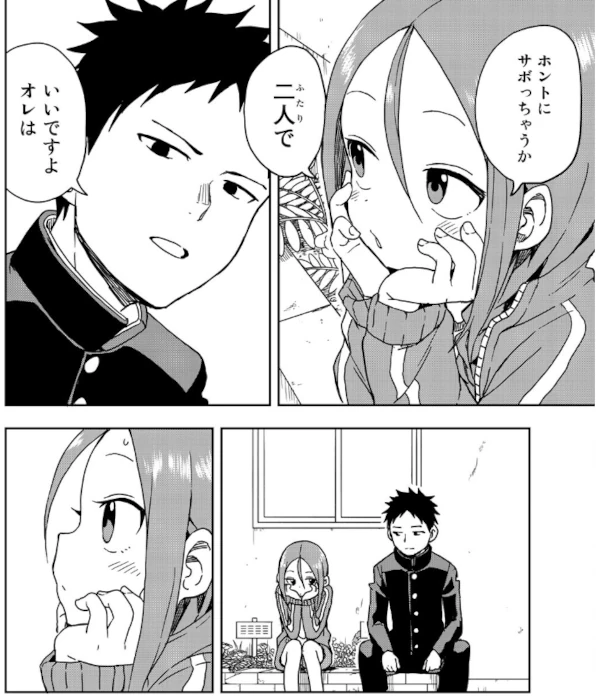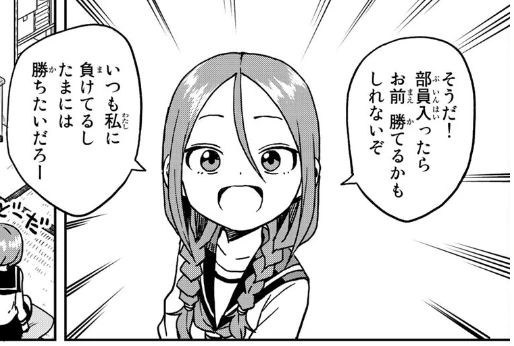This time, we’re introducing Soredemo Ayumu wa Yosetekuru—a manga perfect for learning natural and courteous Japanese through sweet everyday conversations.
Work Information

Soredemo Ayumu wa yosetekuru (それでも歩は寄せてくる)
Author: Soichiro Yamamoto
Publisher: KODANSHA
Amount of text: sparse
Challenge level: ★
Latest volume : Vol.17(Dec.2023 / Completed)
Story overview
A heartwarming shogi romantic comedy by Souichirou Yamamoto, creator of ‘Teasing Master Takagi-san’! Will this love be checkmated or not? Ayumu Tanaka, a beginner at shogi, wants to defeat his club president Urushi Yaotome and confess his feelings. Although his shogi skills are far from perfect, Ayumu’s persistent approach might put Senpai in ‘checkmate’ in a different sense… That’s the story.
The Appeal of This Manga
This work can be seen as a gender-swapped take on the recent surge of manga in the so-called “Takagi-san genre.” What makes it even more interesting is that it’s created by the very same author behind Teasing Master Takagi-san—the manga that started the whole genre. As expected, it still delivers that signature mix of sweet frustration, playful tension, and heart-pounding moments. But by switching the roles of the boy and girl, it brings a fresh new charm to the table.

For context, the “Takagi-san genre” is a nickname for manga similar in style and tone to Teasing Master Takagi-san. These works typically share the following features:
・The title often follows the pattern of “Name-san is something,” usually featuring a person’s name.
・The core story revolves around an ordinary boy being teased or involved with a girl.
・The setting usually focuses on everyday moments in student life.
・The girl is often portrayed as annoyingly cute or playfully mischievous.
・The characters stay in a will-they-won’t-they relationship for a long time.
(Source: ニコニコ大百科)
All in all, this is a must-read for fans of the “Takagi-san genre.” Even if you’re not familiar with it, if you enjoy stories that capture the sweet, awkward thrill of adolescence, this one’s definitely worth checking out.
Why this manga is suitable for learning Japanese
This manga is not only entertaining but also highly recommended for Japanese learners for several reasons.
The junior always uses polite language with the senior.
The main character, Tanaka, always speaks politely to his senior, Urushi, who is one grade above him. Since their conversations are between high school students, the manga features a lot of polite expressions that are not overly formal, focusing mainly on courteous language, making it relatively casual.

The story is simple with minimal dialogue.
This work features very few characters and mainly focuses on the interactions between Tanaka and Urushi, without a complex plot structure. Since there isn’t a lot of dialogue, it serves as an accessible resource for beginners learning Japanese.

The English version is also available
Since this work has been translated into English, you can check any parts you didn’t understand while reading the Japanese version by referring to the English edition.
Phrase Spotlight
“I Mean…”: How ‘っていうか’ Softens (or Strengthens) What You Say攻めてるっていうか、本当のことですから

Let’s take a closer look at how 「っていうか」 works here.
What does 「っていうか」 mean in Japanese?
The phrase 「っていうか」 is super common in everyday Japanese. It’s often used to:
・rephrase or clarify something
・soften or correct what was just said
・introduce a more accurate or honest expression
In English, it’s similar to saying:
“I mean,” “more like,” “or rather,” or “you could say.”
Breakdown of the sentence:
攻めてる = “You’re being bold” / “You’re making a move”
っていうか = “I mean” / “More like”
本当のことですから = “Because it’s the truth”
So Tanaka is basically saying:
→ “Bold? I mean, I’m just telling the truth.”
He’s gently rejecting the idea that he’s flirting or being overly forward, and instead insists that he’s simply being honest.
Why this is useful for learners:
You’ll hear 「っていうか」 all the time in casual conversations, especially when people:
・Adjust what they just said:
「ちょっと…っていうか、かなり寒いね!」
“A little… actually, it’s really cold!”
・Correct or soften a comment:
「怒ってる、っていうか落ち込んでるだけ。」
“I’m not mad, I’m just feeling down.”
It’s a great phrase to make your Japanese sound more natural and nuanced.
A quick note:
While 「っていうか」 is a very common and useful phrase in casual Japanese, it’s important to be mindful of how and when you use it.
Originally, 「っていうか」 came from colloquial, youth-oriented speech and has a casual, laid-back tone. Over time, it’s become widespread in daily conversation, even among adults—but it still carries that casual flavor. Because of this, it’s best avoided in formal situations, such as business meetings or polite conversations with superiors.
Also, using it too frequently can make your speech sound repetitive or unpolished, as if you’re constantly backtracking or unsure of what you’re saying. It’s a bit like saying “I mean” or “like” too much in English—it’s natural in moderation, but distracting if overused.
So while 「っていうか」 is great for making your Japanese sound more natural and expressive, especially in casual settings, try to use it strategically and sparingly!
A Little Warning
Urushi’s tone is somewhat authoritative.
Urushi maintains a character that does not lose her dignity as a senior when interacting with Tanaka, so her tone is somewhat authoritative. Since this manner of speaking is not common among young women, it might be best not to imitate it too closely.

You won’t become knowledgeable about shogi.
Although the story follows the romance between a senior and a junior connected through shogi, there are few descriptions of shogi itself. Therefore, you can’t expect to become familiar with the rules of shogi or to improve your skills by reading this work.
Work Information

Soredemo Ayumu wa yosetekuru (それでも歩は寄せてくる)
Author: Soichiro Yamamoto
Publisher: KODANSHA
Amount of text: sparse
Challenge level: ★
Latest volume : Vol.17(Dec.2023 / Completed)
Here’s a safe and convenient way to purchase Japanese manga.
This Blog’s ConceptIn this blog, we are introducing manga that are not only highly captivating but also ideal for Japanese language learners. Studying Japanese through manga is both fun and effective. Manga allows you to understand the subtleties of keigo (honorifics), teineigo (polite speech), and casual conversation in Japanese. We hope you find works that match your interests and use them to enhance your Japanese learning journey.